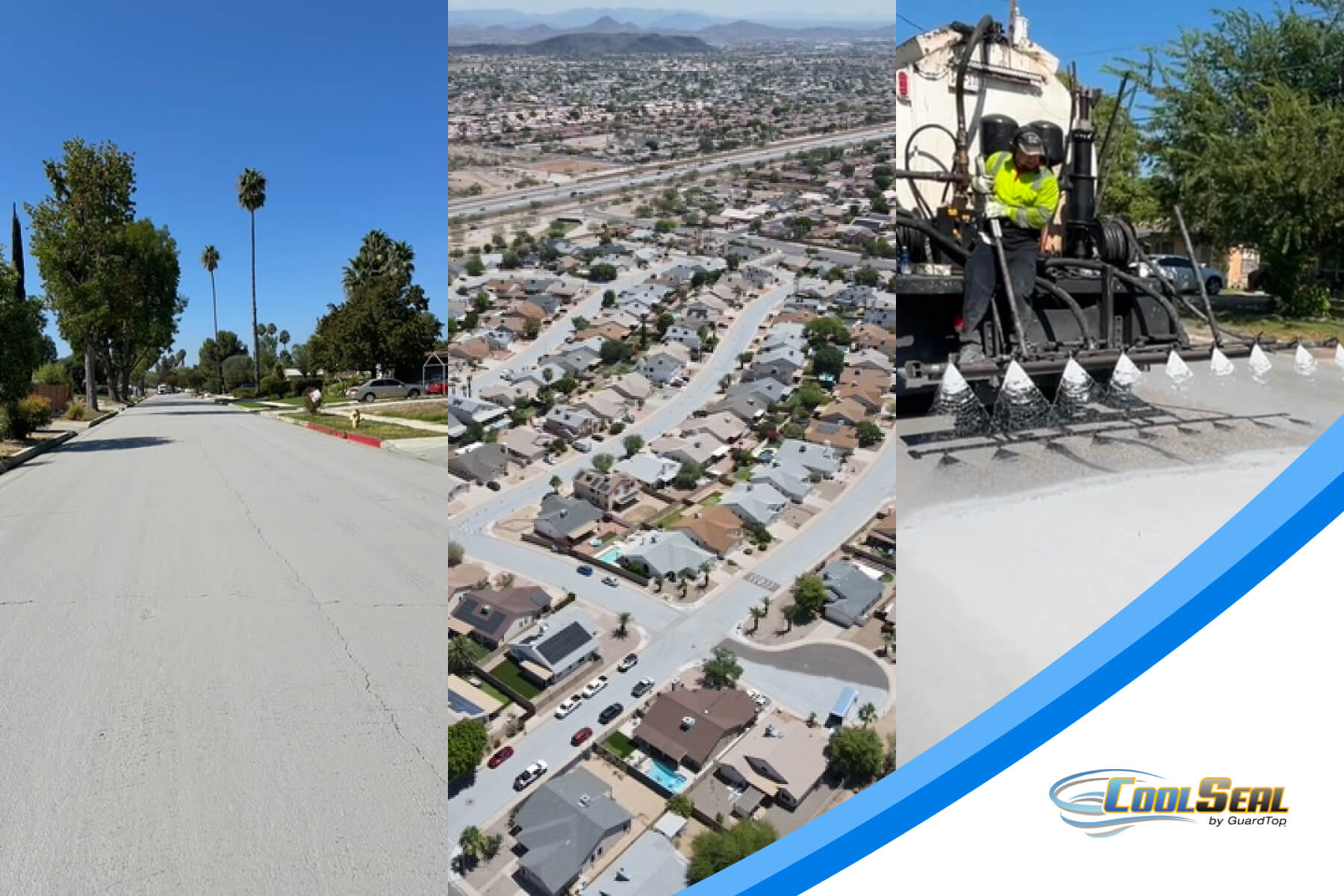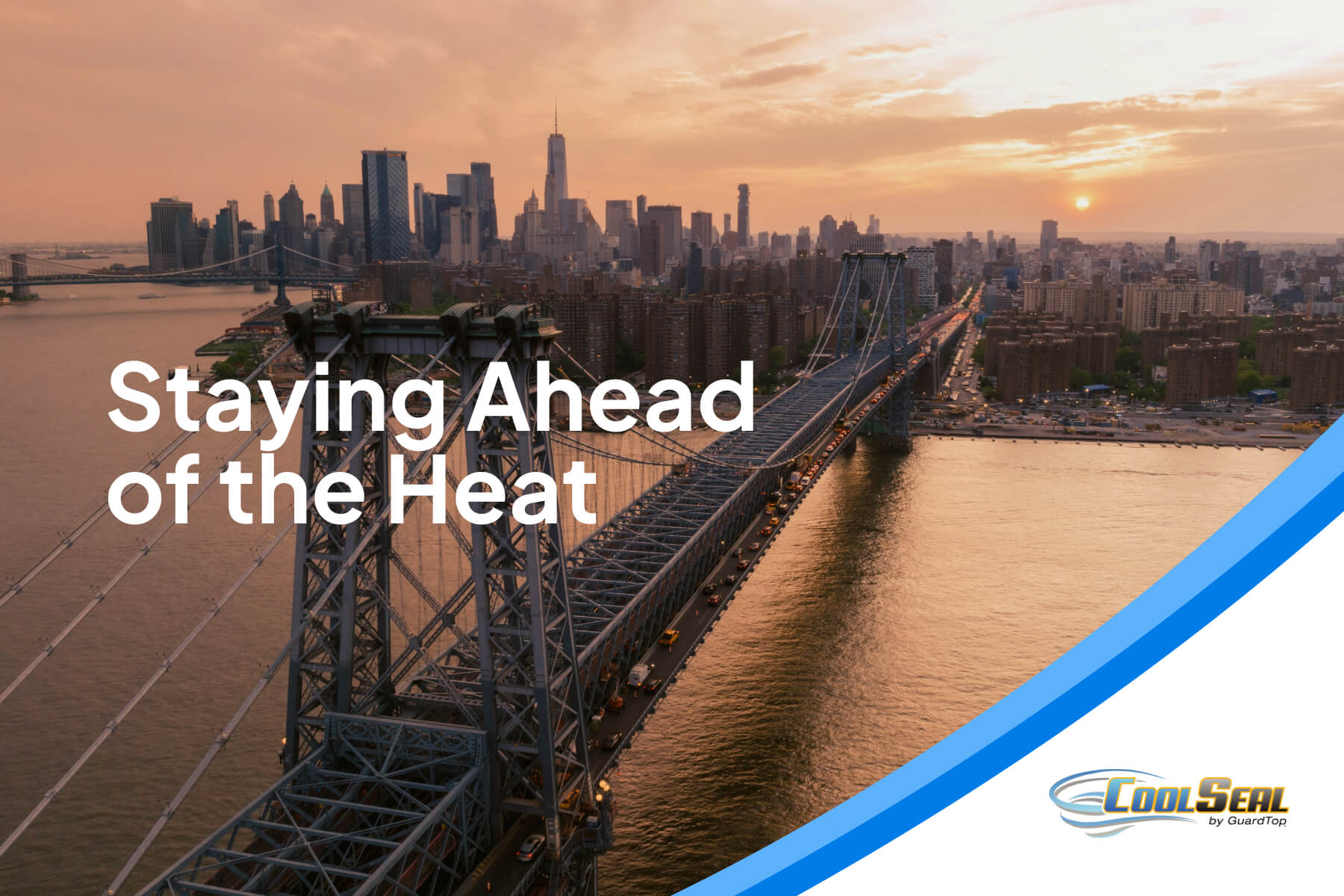
Proven to Outperform
Among many other city initiatives currently in progress, CoolSeal has most notably been put to the test by the City of Phoenix, Arizona, as part of their Cool Pavement Pilot Program and Los Angeles’ Cool Streets LA. The results—CoolSeal is proving to be the best choice, and only fully-green choice, for cities seeking heat relief, energy savings and innovative, long-term solutions.
Cool Pavement Pilot Program
In 2020, the City of Phoenix Street Transportation Department and Office of Sustainability teamed up with Arizona State University (ASU) researchers to begin the "Cool Pavement Pilot Program," aimed at cooling down neighborhoods and saving energy costs. To launch their program, CoolSeal was applied to 36 miles of neighborhood roads and a parking lot. Due to overwhelmingly positive results, Phoenix now boasts over 120 miles of CoolSeal city wide and cool pavement is now a permanent part of the Street Transportation Department's street maintenance program.
sunlight reflected absorbing less heat
Untreated asphalt has a reflectivity of only 12 percent.
cooler surface temperatures
Phoenix saw lower surface temperatures by 10-16 °F compared to uncoated asphalt; 20°F compared to black-coat asphalt
projected energy cost savings
Reduced temperatures could save residential ratepayers tens of million per year in avoided air conditioning costs and the city tens of millions in energy costs

How It Works
Reflective Formula
Coolseal's unique formula, which is made with recycled materials and free of harmful chemicals, is designed to convert solar heat / harmful UV rays into other forms of light, interrupting heat absorption.
Temperature Reduction
This reflection of sunlight directly reduces the surface temperature of the pavement, often by 10-20 degrees Fahrenheit under certain conditions, making it cooler to the touch and the surrounding area more comfortable.
Urban Warming and Heat Island Mitigation
By lowering pavement temperatures, CoolSeal contributes to reducing ambient temperatures and the urban heat island effect, which is the temperature disparity between urban areas and their rural surroundings.
Sustainability
CoolSeal leverages eco-friendly materials to cut waste and toxic emissions, enhancing community life by cooling the pavements, which extends their life, reduces upkeep costs, and fosters more sustainable urban infrastructure.
CoolSeal at Work
Get the latest updates on cooling communities and creating change.

A Look Back at 2025! CoolSeal’s Progress in Cooling Communities

Stay Ahead of the Heat! 2025-2026 Programs and Planning Resources for Cities

CoolSeal Joins the Reflect Effect Event in Los Angeles
FAQs
Find answers to commonly asked questions about CoolSeal's innovative asphalt sealcoat.
The Cool Pavement Pilot Program was created by the City of Phoenix Office of Sustainability, the Street Transportation Department, and Arizona State University (ASU) with the goal of improving the livability of the city by cooling down neighborhoods and reducing energy costs.
To launch the program, CoolSeal by GuardTop was applied to 36 miles of neighborhood roads and one public parking lot in the city of Phoenix in 2020.
In a virtual presentation and panel discussion on September 14, 2021, the City of Phoenix released the results of the first year of this innovative program. The study, performed by scientists at ASU’s Global Institute of Sustainability and Innovation, Healthy Urban Environments, and the Urban Climate Research Center, found that the reflective pavement surface temperatures of CoolSeal by GuardTop are considerably lower than traditional roadway pavement. Cool pavement coating reflects a higher portion of the sunlight that hits it, and because of this higher reflection, the coating has the potential to offset rising nighttime temperatures in the region. So far, the study has revealed that the nighttime air temperature at six feet of height was on average 0.5 degrees Fahrenheit lower over cool pavement than on the non-treated surfaces. In addition, cool pavement had an average surface temperature 10.5 to 12 degrees Fahrenheit lower than traditional asphalt at noon and during afternoon hours. Sub-surface temperatures averaged 4.8 degrees Fahrenheit lower in areas treated with cool pavement, too.
With this pilot program, Phoenix now has the most cool pavement in North America. Los Angeles, California is following in its footsteps, with Mayor Eric Garcetti recently kicking off the next phase of his ‘Cool Streets L.A.’ program, which will bring 200 blocks of cool pavement and nearly 2,000 new trees to eight neighborhoods across Los Angeles. CoolSeal also has a large presence in Australia, with a total of roughly two million square feet of cool pavement applied. Australia has benefited from reduced ambient temperatures and has led global efforts in going green with cool pavement.
Reducing surface temperatures and mean radiant temperature can lead to less energy use in the summer. Planting more trees and increasing vegetation cover, green spaces, and rooftop gardens helps absorb carbon dioxide, as well as protect against erosion and reduce stormwater runoff. Using surface materials like CoolSeal, which incorporates recycled materials in its formula and is free of polymers, hazardous volatiles, and carcinogenic additives, provides additional environmental benefits.
CoolSeal reflects 30% more sunlight and lowers surface temperatures by 10-16℉, compared to uncoated asphalt. It can lower surface temperatures by up to 20℉ as compared to black-coat asphalt. It also lowers subsurface temperatures by nearly 5℉, resulting in long-lasting surfaces that reduce maintenance needs and save on costs.
Our special blend is designed to be resistant to cracking and wear and tear. Properly applied, a two-coat application of CoolSeal can last twice as long as conventional sealcoat and require less maintenance.
Because CoolSeal lasts longer and provides stellar protection for asphalt, property owners and communities can make the most of their asphalt investment and save money over time with fewer repairs and longer cycles between asphalt replacement.
CoolSeal is manufactured with recycled materials and doesn’t use fossil fuels like tar coal or bitumen. It’s been proven to lower surface temperatures by an average of 12 degrees Fahrenheit during peak afternoon heat, as compared to traditional products. This cooling effect not only creates more comfortable environments, it can help decrease energy demand, which is associated with lower associated air pollution and greenhouse gas emissions. Additionally, when applied correctly, CoolSeal lasts twice as long as conventional sealcoats and increases the longevity of asphalt, thus reducing the cycle of asphalt replacement and waste.
At this time, CoolSeal is not available for direct application to individual community residences. However, if you are interested in using CoolSeal for your residence or community, there are options to consider: Minimum Purchase Requirement: For individual applications, a minimum purchase of 100 gallons ($195 per bucket, 20 buckets), which covers at least 3,000 square feet, is required. Collaborate with Neighbors: Pool resources with nearby residents who may also be interested in using CoolSeal. This can help you meet the minimum purchase requirement and make the application process more feasible. Advocate for Neighborhood Use: Consider reaching out to your local city officials. You can write a letter or petition, requesting that CoolSeal be made available for neighborhood use. Increased interest from the community may encourage support for smaller residential projects.






